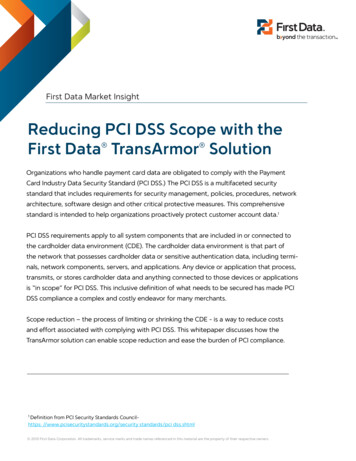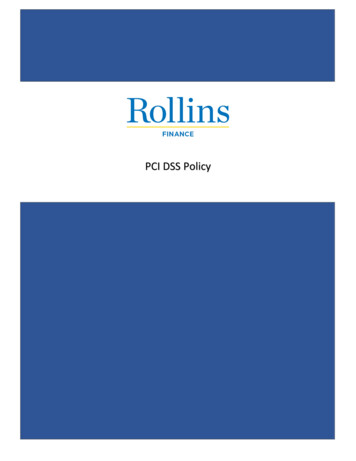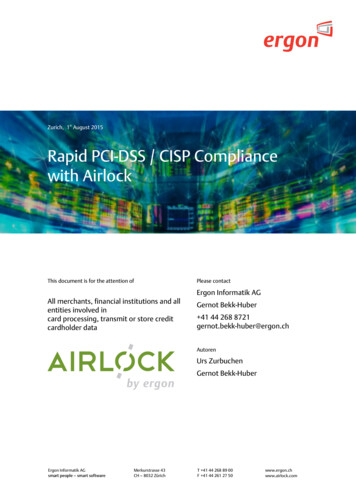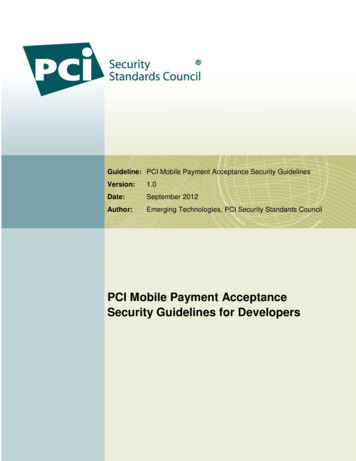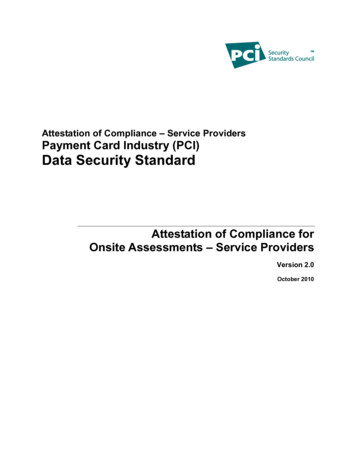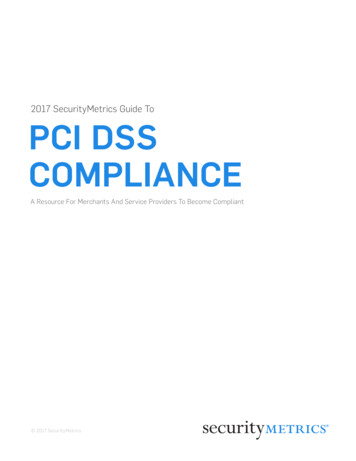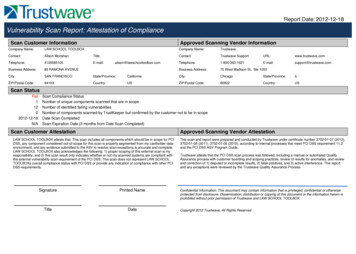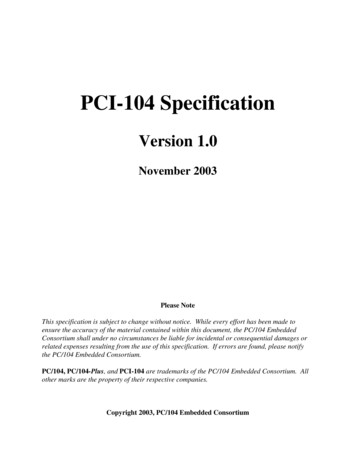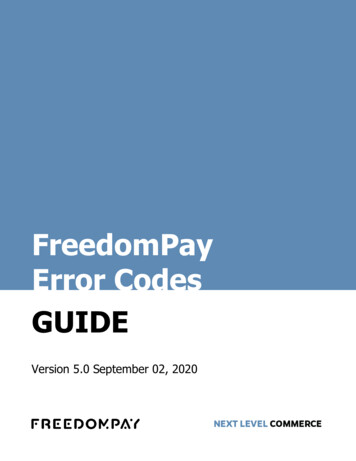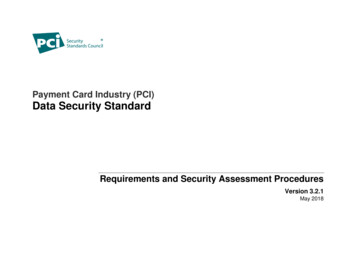
Transcription
Payment Card Industry (PCI)Data Security StandardRequirements and Security Assessment ProceduresVersion 3.2.1May 2018
Document ChangesDateOctober 2008July 2009Version1.21.2.1DescriptionPagesTo introduce PCI DSS v1.2 as “PCI DSS Requirements and Security Assessment Procedures,”eliminating redundancy between documents, and make both general and specific changes fromPCI DSS Security Audit Procedures v1.1. For complete information, see PCI Data SecurityStandard Summary of Changes from PCI DSS Version 1.1 to 1.2.Add sentence that was incorrectly deleted between PCI DSS v1.1 and v1.2.5Correct “then” to “than” in testing procedures 6.3.7.a and 6.3.7.b.32Remove grayed-out marking for “in place” and “not in place” columns in testing procedure 6.5.b.33For Compensating Controls Worksheet – Completed Example, correct wording at top of page tosay “Use this worksheet to define compensating controls for any requirement noted as ‘in place’via compensating controls.”64October 20102.0Update and implement changes from v1.2.1. See PCI DSS – Summary of Changes from PCIDSS Version 1.2.1 to 2.0.November 20133.0Update from v2.0. See PCI DSS – Summary of Changes from PCI DSS Version 2.0 to 3.0.April 20153.1Update from PCI DSS v3.0. See PCI DSS – Summary of Changes from PCI DSS Version 3.0 to3.1 for details of changes.April 20163.2Update from PCI DSS v3.1. See PCI DSS – Summary of Changes from PCI DSS Version 3.1 to3.2 for details of changes.May 20183.2.1Update from PCI DSS v3.2. See PCI DSS – Summary of Changes from PCI DSS Version 3.2 to3.2.1 for details of changes.Payment Card Industry (PCI) Data Security Standard, v3.2.1 2006-2018 PCI Security Standards Council, LLC. All Rights Reserved.Page 2May 2018
Table of ContentsDocument Changes . 2Introduction and PCI Data Security Standard Overview . 5PCI DSS Resources . 6PCI DSS Applicability Information . 7Relationship between PCI DSS and PA-DSS. 9Applicability of PCI DSS to PA-DSS Applications . 9Applicability of PCI DSS to Payment Application Vendors. 9Scope of PCI DSS Requirements . 10Network Segmentation . 11Wireless. 11Use of Third-Party Service Providers / Outsourcing . 12Best Practices for Implementing PCI DSS into Business-as-Usual Processes . 13For Assessors: Sampling of Business Facilities/System Components . 15Compensating Controls . 16Instructions and Content for Report on Compliance . 17PCI DSS Assessment Process . 17PCI DSS Versions . 18Detailed PCI DSS Requirements and Security Assessment Procedures . 19Build and Maintain a Secure Network and Systems . 20Requirement 1: Install and maintain a firewall configuration to protect cardholder data . 20Requirement 2: Do not use vendor-supplied defaults for system passwords and other security parameters . 29Protect Cardholder Data . 36Requirement 3: Protect stored cardholder data . 36Requirement 4: Encrypt transmission of cardholder data across open, public networks . 47Maintain a Vulnerability Management Program . 50Requirement 5: Protect all systems against malware and regularly update anti-virus software or programs . 50Requirement 6: Develop and maintain secure systems and applications . 53Implement Strong Access Control Measures . 66Requirement 7: Restrict access to cardholder data by business need to know . 66Payment Card Industry (PCI) Data Security Standard, v3.2.1 2006-2018 PCI Security Standards Council, LLC. All Rights Reserved.Page 3May 2018
Requirement 8:Requirement 9:Identify and authenticate access to system components . 69Restrict physical access to cardholder data . 79Regularly Monitor and Test Networks . 88Requirement 10: Track and monitor all access to network resources and cardholder data . 88Requirement 11: Regularly test security systems and processes. . 96Maintain an Information Security Policy . 105Requirement 12: Maintain a policy that addresses information security for all personnel. . 105Appendix A: Additional PCI DSS Requirements . 116Appendix A1: Additional PCI DSS Requirements for Shared Hosting Providers . 117Appendix A2: Additional PCI DSS Requirements for Entities using SSL/Early TLS for Card-Present POS POI Terminal Connections . 119Appendix A3: Designated Entities Supplemental Validation (DESV) . 122Appendix B: Compensating Controls . 136Appendix C: Compensating Controls Worksheet . 137Appendix D: Segmentation and Sampling of Business Facilities/System Components . 139Payment Card Industry (PCI) Data Security Standard, v3.2.1 2006-2018 PCI Security Standards Council, LLC. All Rights Reserved.Page 4May 2018
Introduction and PCI Data Security Standard OverviewThe Payment Card Industry Data Security Standard (PCI DSS) was developed to encourage and enhance cardholder data security and facilitatethe broad adoption of consistent data security measures globally. PCI DSS provides a baseline of technical and operational requirementsdesigned to protect account data. PCI DSS applies to all entities involved in payment card processing—including merchants, processors,acquirers, issuers, and service providers. PCI DSS also applies to all other entities that store, process or transmit cardholder data (CHD) and/orsensitive authentication data (SAD). Below is a high-level overview of the 12 PCI DSS requirements.PCI Data Security Standard – High Level OverviewBuild and Maintain a SecureNetwork and SystemsProtect Cardholder DataMaintain a VulnerabilityManagement ProgramImplement Strong AccessControl Measures1.2.Install and maintain a firewall configuration to protect cardholder dataDo not use vendor-supplied defaults for system passwords and othersecurity parameters3.4.Protect stored cardholder dataEncrypt transmission of cardholder data across open, public networks5.6.Protect all systems against malware and regularly update anti-virussoftware or programsDevelop and maintain secure systems and applications7.8.9.Restrict access to cardholder data by business need to knowIdentify and authenticate access to system componentsRestrict physical access to cardholder dataRegularly Monitor and TestNetworks10.11.Track and monitor all access to network resources and cardholder dataRegularly test security systems and processesMaintain an InformationSecurity Policy12.Maintain a policy that addresses information security for all personnelThis document, PCI Data Security Standard Requirements and Security Assessment Procedures, combines the 12 PCI DSS requirements andcorresponding testing procedures into a security assessment tool. It is designed for use during PCI DSS compliance assessments as part of anentity’s validation process. The following sections provide detailed guidelines and best practices to assist entities prepare for, conduct, and reportthe results of a PCI DSS assessment. The PCI DSS Requirements and Testing Procedures begin on page 15.PCI DSS comprises a minimum set of requirements for protecting account data, and may be enhanced by additional controls and practices tofurther mitigate risks, as well as local, regional and sector laws and regulations. Additionally, legislation or regulatory requirements may requirespecific protection of personal information or other data elements (for example, cardholder name). PCI DSS does not supersede local or regionallaws, government regulations, or other legal requirements.Payment Card Industry (PCI) Data Security Standard, v3.2.1 2006-2018 PCI Security Standards Council, LLC. All Rights Reserved.Page 5May 2018
PCI DSS ResourcesThe PCI Security Standards Council (PCI SSC) website (www.pcisecuritystandards.org) contains a number of additional resources to assistorganizations with their PCI DSS assessments and validations, including: Document Library, including:oPCI DSS – Summary of Changes from PCI DSS version 2.0 to 3.0oPCI DSS Quick Reference GuideoPCI DSS and PA-DSS Glossary of Terms, Abbreviations, and AcronymsoInformation Supplements and GuidelinesoPrioritized Approach for PCI DSSoReport on Compliance (ROC) Reporting Template and Reporting InstructionsoSelf-assessment Questionnaires (SAQs) and SAQ Instructions and GuidelinesoAttestations of Compliance (AOCs) Frequently Asked Questions (FAQs) PCI for Small Merchants website PCI training courses and informational webinars List of Qualified Security Assessors (QSAs) and Approved Scanning Vendors (ASVs) List of PTS approved devices and PA-DSS validated payment applicationsNote: Information Supplementscomplement the PCI DSS and identifyadditional considerations andrecommendations for meeting PCI DSSrequirements—they do not supersede,replace or extend the PCI DSS or any of itsrequirements.Please refer to www.pcisecuritystandards.org for information about these and other resources.Payment Card Industry (PCI) Data Security Standard, v3.2.1 2006-2018 PCI Security Standards Council, LLC. All Rights Reserved.Page 6May 2018
PCI DSS Applicability InformationPCI DSS applies to all entities involved in payment card processing—including merchants, processors, acquirers, issuers, and service providers.PCI DSS also applies to all other entities that store, process, or transmit cardholder data and/or sensitive authentication data.Cardholder data and sensitive authentication data are defined as follows:Account DataCardholder Data includes: Primary Account Number (PAN) Cardholder Name Sensitive Authentication Data includes: Full track data (magnetic-stripe data orequivalent on a chip)Expiration Date CAV2/CVC2/CVV2/CIDService Code PINs/PIN blocksThe primary account number is the defining factor for cardholder data. If cardholder name, service code, and/or expiration date arestored, processed or transmitted with the PAN, or are otherwise present in the cardholder data environment (CDE), they must be protected inaccordance with applicable PCI DSS requirements.PCI DSS requirements apply to organizations where account data (cardholder data and/or sensitive authentication data) is stored, processed ortransmitted. Some PCI DSS requirements may also be applicable to organizations that have outsourced their payment operations ormanagement of their CDE. 1 Additionally, organizations that outsource their CDE or payment operations to third parties are responsible forensuring that the account data is protected by the third party per the applicable PCI DSS requirements.The table on the following page illustrates commonly used elements of cardholder and sensitive authentication data, whether storage of eachdata element is permitted or prohibited, and whether each data element must be protected. This table is not exhaustive, but is presented toillustrate the different types of requirements that apply to each data element.1In accordance with individual payment brand compliance programsPayment Card Industry (PCI) Data Security Standard, v3.2.1 2006-2018 PCI Security Standards Council, LLC. All Rights Reserved.Page 7May 2018
Account DataCardholderDataSensitiveAuthenticationData 2Data ElementStoragePermittedRender Stored Data Unreadable perRequirement 3.4Primary Account Number (PAN)YesYesCardholder NameYesNoService CodeYesNoExpiration DateYesNoFull Track Data 3NoCannot store per Requirement 3.2CAV2/CVC2/CVV2/CID 4NoCannot store per Requirement 3.2PIN/PIN Block 5NoCannot store per Requirement 3.2PCI DSS Requirements 3.3 and 3.4 apply only to PAN. If PAN is stored with other elements of cardholder data, only the PAN must be renderedunreadable according to PCI DSS Requirement 3.4.Sensitive authentication data must not be stored after authorization, even if encrypted. This applies even where there is no PAN in theenvironment. Organizations should contact their acquirer or the individual payment brands directly to understand whether SAD is permitted to bestored prior to authorization, for how long, and any related usage and protection requirements.2345Sensitive authentication data must not be stored after authorization (even if encrypted).Full track data from the magnetic stripe, equivalent data on the chip, or elsewhereThe three- or four-digit value printed on the front or back of a payment cardPersonal identification number entered by cardholder during a card-present transaction, and/or encrypted PIN block present within the transaction messagePayment Card Industry (PCI) Data Security Standard, v3.2.1 2006-2018 PCI Security Standards Council, LLC. All Rights Reserved.Page 8May 2018
Relationship between PCI DSS and PA-DSSApplicability of PCI DSS to PA-DSS ApplicationsUse of a Payment Application Data Security Standard (PA-DSS) compliant application by itself does not make an entity PCI DSS compliant, sincethat application must be implemented into a PCI DSS compliant environment and according to the PA-DSS Implementation Guide provided by thepayment application vendor.All applications that store, process, or transmit cardholder data are in scope for an entity’s PCI DSS assessment, including applications that havebeen validated to PA-DSS. The PCI DSS assessment should verify the PA-DSS validated payment application is properly configured and securelyimplemented per PCI DSS requirements. If the payment application has undergone any customization, a more in-depth review will be requiredduring the PCI DSS assessment, as the application may no longer be representative of the version that was validated to PA-DSS.The PA-DSS requirements are derived from the PCI DSS Requirements and Security Assessment Procedures (defined in this document). ThePA-DSS details the requirements a payment application must meet in order to facilitate a customer’s PCI DSS compliance. As security threats areconstantly evolving, applications that are no longer supported by the vendor (e.g., identified by the vendor as “end of life”) may not offer the samelevel of security as supported versions.Secure payment applications, when implemented in a PCI DSS-compliant environment, will minimize the potential for security breaches leading tocompromises of PAN, full track data, card verification codes and values (CAV2, CID, CVC2, CVV2), and PINs and PIN blocks, along with thedamaging fraud resulting from these breaches.To determine whether PA-DSS applies to a given payment application, please refer to the PA-DSS Program Guide, which can be found atwww.pcisecuritystandards.org.Applicability of PCI DSS to Payment Application VendorsPCI DSS may apply to payment application vendors if the vendor stores, processes, or transmits cardholder data, or has access to theircustomers’ cardholder data (for example, in the role of a service provider).Payment Card Industry (PCI) Data Security Standard, v3.2.1 2006-2018 PCI Security Standards Council, LLC. All Rights Reserved.Page 9May 2018
Scope of PCI DSS RequirementsThe PCI DSS security requirements apply to all system components included in or connected to the cardholder data environment. The cardholderdata environment (CDE) is comprised of people, processes and technologies that store, process, or transmit cardholder data or sensitiveauthentication data. “System components” include network devices, servers, computing devices, and applications. Examples of systemcomponents include but are not limited to the following: Systems that provide security services (for example, authentication servers), facilitate segmentation (for example, internal firewalls), ormay impact the security of (for example, name resolution or web redirection servers) the CDE. Virtualization components such as virtual machines, virtual switches/routers, virtual appliances, virtual applications/desktops, andhypervisors. Network components including but not limited to firewalls, switches, routers, wireless access points, network appliances, and othersecurity appliances. Server types including but not limited to web, application, database, authentication, mail, proxy, Network Time Protocol (NTP), andDomain Name System (DNS). Applications including all purchased and custom applications, including internal and external (for example, Internet) applications. Any other component or device located within or connected to the CDE.The first step of a PCI DSS assessment is to accurately determine the scope of the review. At least annually and prior to the annual assessment,the assessed entity should confirm the accuracy of their PCI DSS scope by identifying all locations and flows of cardholder data, and identify allsystems that are connected to or, if compromised, could impact the CDE (for example, authentication servers) to ensure they are included in thePCI DSS scope. All types of systems and locations should be considered as part of the scoping process, including backup/recovery sites and failover systems.To confirm the accuracy of the defined CDE, perform the following: The assessed entity identifies and documents the existence of all cardholder data in their environment, to verify that no cardholder dataexists outside of the currently defined CDE. Once all locations of cardholder data are identified and documented, the entity uses the results to verify that PCI DSS scope is appropriate(for example, the results may be a diagram or an inventory of cardholder data locations). The entity considers any cardholder data found to be in scope of the PCI DSS assessment and part of the CDE. If the entity identifies datathat is not currently included in the CDE, such data should be securely deleted, migrated into the currently defined CDE, or the CDEredefined to include this data.The entity retains documentation that shows how PCI DSS scope was determined. The documentation is retained for assessor review and/or forreference during the next annual PCI DSS scope confirmation activity.For each PCI DSS assessment, the assessor is required to validate that the scope of the assessment is accurately defined and documented.Payment Card Industry (PCI) Data Security Standard, v3.2.1 2006-2018 PCI Security Standards Council, LLC. All Rights Reserved.Page 10May 2018
Network SegmentationNetwork segmentation of, or isolating (segmenting), the cardholder data environment from the remainder of an entity’s network is not a PCI DSSrequirement. However, it is strongly recommended as a method that may reduce: The scope of the PCI DSS assessment The cost of the PCI DSS assessment The cost and difficulty of implementing and maintaining PCI DSS controls The risk to an organization (reduced by consolidating cardholder data into fewer, more controlled locations)Without adequate network segmentation (sometimes called a "flat network") the entire network is in scope of the PCI DSS assessment. Networksegmentation can be achieved through a number of physical or logical means, such as properly configured internal network firewalls, routers withstrong access control lists, or other technologies that restrict access to a particular segment of a network. To be considered out of scope for PCIDSS, a system component must be properly isolated (segmented) from the CDE, such that even if the out-of-scope system component wascompromised it could not impact the security of the CDE.An important prerequisite to reduce the scope of the cardholder data environment is a clear understanding of business needs and processesrelated to the storage, processing or transmission of cardholder data. Restricting cardholder data to as few locations as possible by elimination ofunnecessary data, and consolidation of necessary data, may require reengineering of long-standing business practices.Documenting cardholder data flows via a dataflow diagram helps fully understand all cardholder data flows and ensures that any networksegmentation is effective at isolating the cardholder data environment.If network segmentation is in place and being used to reduce the scope of the PCI DSS assessment, the assessor must verify that thesegmentation is adequate to reduce the scope of the assessment. At a high level, adequate network segmentation isolates systems that store,process, or transmit cardholder data from those that do not. However, the adequacy of a specific implementation of network segmentation is highlyvariable and dependent upon a number of factors, such as a given network's configuration, the technologies deployed, and other controls that maybe implemented.Appendix D: Segmentation and Sampling of Business Facilities/System Components provides more information on the effect of networksegmentation and sampling on the scope of a PCI DSS assessment.WirelessIf wireless technology is used to store, process, or transmit cardholder data (for example, point-of-sale transactions, “line-busting”), or if a wirelesslocal area network (WLAN) is part of, or connected to the cardholder data environment, the PCI DSS requirements and testing procedures forwireless environments apply and must be performed (for example, Requirements 1.2.3, 2.1.1, and 4.1.1). Before wireless technology isimplemented, an entity should carefully evaluate the need for the technology against the risk. Consider deploying wireless technology only for nonsensitive data transmission.Payment Card Industry (PCI) Data Security Standard, v3.2.1 2006-2018 PCI Security Standards Council, LLC. All Rights Reserved.Page 11May 2018
Use of Third-Party Service Providers / OutsourcingA service provider or merchant may use a third-party service provider to store, process, or transmit cardholder data on their behalf, or to managecomponents such as routers, firewalls, databases, physical security, and/or servers. If so, there may be an impact on the security of the cardholderdata environment.Parties should clearly identify the services and system components which are included in the scope of the service provider’s PCI DSSassessment, the specific PCI DSS requirements covered by the service provider, and any requirements which are the responsibility of the serviceprovider’s customers to include in their own PCI DSS reviews. For example, a managed hosting provider should clearly define which of their IPaddresses are scanned as part of their quarterly vulnerability scan process and which IP addresses are their customer’s responsibility to include intheir own quarterly scans.Service providers are responsible for demonstrating their PCI DSS compliance, and may be required to do so by the payment brands. Serviceproviders should contact their acquirer and/or payment brand to determine the appropriate compliance validation.There are two options for third-party service providers to validate compliance:1) Annual assessment: Service providers can undergo an annual PCI DSS assessment(s) on their own and provide evidence to theircustomers to demonstrate their compliance; or2) Multiple, on-demand assessments: If they do not undergo their own annual PCI DSS assessments, service providers must undergoassessments upon request of their customers and/or participate in each of their customer’s PCI DSS reviews, with the results of eachreview provided to the respective customer(s)If the third party undergoes their own PCI DSS assessment, they should provide sufficient evidence to their customers to verify that the scope ofthe service provider’s PCI DSS assessment covered the services applicable to the customer and that the relevant PCI DSS requirements wereexamined and determined to be in place. The specific type of evidence provided by the service provider to their customers will depend on theagreements/contracts in place between those parties. For example, providing the AOC and/or relevant sections of the service provider’s ROC(redacted to protect any confidential information) could help provide all or some of the information.Additionally, merchants and service providers must manage and monitor the PCI DSS compliance of all associated third-party service providerswith access to cardholder data. Refer to Requirement 12.8 in this document for details.Payment Card Industry (PCI) Data Security Standard, v3.2.1 2006-2018 PCI Security Standards Council, LLC. All Rights Reserved.Page 12May 2018
Best Practices for Implementing PCI DSS into Business-as-Usual ProcessesTo ensure security controls continue to be properly implemented, PCI DSS should be implemented into business-as-usual (BAU) activities as partof an entity’s overall security strategy. This enables an entity to monitor the effectiveness of their security controls on an ongoing basis, andmaintain their PCI DSS compliant environment in between PCI DSS assessments. Examples of how to incorporate PCI DSS into BAU activitiesinclude but are not limited to:1. Monitoring of security controls—such as firewalls, intrusion-detection systems/intrusion-prevention systems (IDS/IPS), file-integritymonitoring (FIM), anti-virus, access controls, etc.—to ensure they are operating effectively and as intended.2. Ensuring that all failures in security con
To introduce PCI DSS v1.2 as "PCI DSS Requirements and Security Assessment Procedures," eliminating redundancy between documents, and make both general and specific changes from
